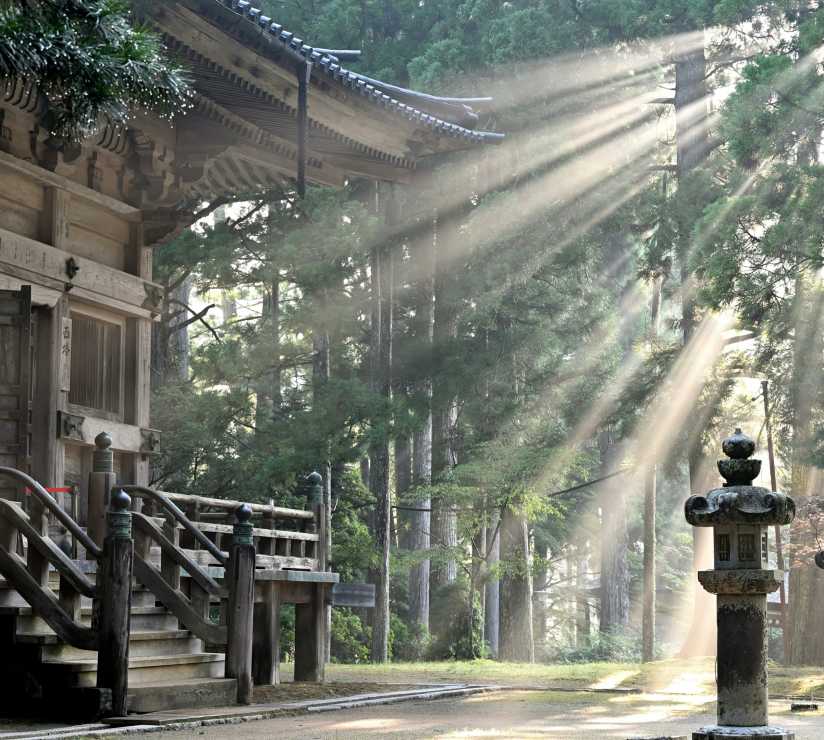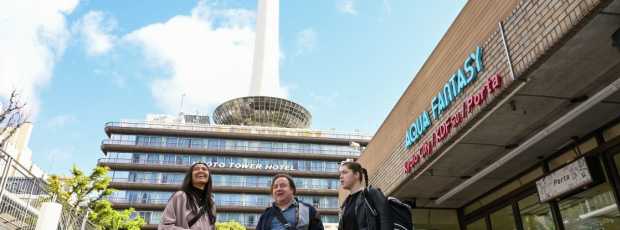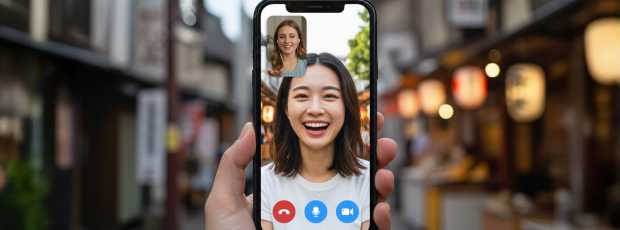Milo was an amazing host in Kyoto. He was very knowledgeable about Kyoto and the broader history of Japan, showed us some hidden gems and made sure the whole family had a great time! We had a great time and highly recommend a tour with Milo!Jeffrey, Kyoto, 2025
Table Of Contents
- Why Kyoto Deserves More Than a Day Trip
- When to Visit Kyoto for the Most Authentic Experience
- Getting Your Bearings: Transportation and Layout
- Sacred Spaces: Kyoto's Temple Legacy
- The Imperial Legacy: Palaces and Power
- Sacred Mountains and Temple Paths
- Gardens That Define Japanese Aesthetics
- Living Culture: Geisha Districts and Traditional Arts
- Arashiyama: Nature and Culture in Harmony
- Cultural Immersion: Markets and Local Experiences
- Seasonal Festivals and Special Events
- Unique Kyoto Experiences Worth Seeking
- Planning Your Kyoto Journey
- Beyond the Guidebook

A peaceful view of Kyoto's historic Higashiyama District at sunrise. Image by Kouji Tsuru from Unsplash
When visitors ask me about the best things to do in Kyoto, I pause before answering.
This ancient city, once Japan's capital for over a thousand years, holds layers of meaning that go far beyond any simple list of attractions.
Having grown up here, watching the seasons paint our temples in different hues and witnessing the quiet persistence of traditions that have shaped Japanese culture for centuries, I've learned that Kyoto shows itself most gracefully to those who approach with patience and respect.

Traditional wooden architecture in early morning light. Image by notinx from Unsplash
My childhood was spent wandering through temple grounds after school, learning the subtle art of the tea ceremony from my grandmother.
I grew up understanding that every corner of this city carries stories passed down through generations of the imperial family and common people alike.
The narrow streets where I played hide-and-seek are the same ones geisha have walked for centuries, their wooden sandals echoing through a city that never forgets its past.

Ancient map overlay showing Kyoto's grid system.
Why Kyoto Deserves More Than a Day Trip
Planning your Kyoto itinerary requires understanding that this city runs on a different beat than most destinations.
While tour groups rush between the golden pavilion and downtown Kyoto, the most profound experiences happen in the spaces between, the moments when you find yourself alone in a temple courtyard, or when you catch the scent of incense drifting from a hidden shrine.
The city's layout follows the ancient Chinese grid system, with central Kyoto serving as the heart from which all districts radiate.
Every area carries its character: the historic district of Higashiyama preserves the atmosphere of old Japan, while the imperial palace grounds offer glimpses into the refined world of court culture.
See Kyoto With Someone Who Gets You
Whether you're into temples, tastings, or tucked-away trails, our local hosts craft a day that fits.

Cherry blossoms floating on the surface of a temple pond. Image by Kouji Tsuru from Unsplash
When to Visit Kyoto for the Most Memorable Experience
Understanding Kyoto's Seasonal Rhythms
Cherry blossom season turns Kyoto into something ethereal, but it also brings the largest crowds.
Having lived through countless springs here, I've learned that the most beautiful cherry blossom moments often happen in early April, just as the petals begin to fall like snow on temple paths.
The key to experiencing cherry blossom season lies in timing and location.

Snow-covered temple roof against a grey winter sky. Image by John Thomas from Unsplash
While Maruyama Park fills with hanami parties, the lesser-known temple gardens offer equally spectacular views with space for contemplation.
Summer brings the Gion Matsuri, Kyoto's most famous festival, but also intense heat and humidity. Autumn paints the surrounding landscape in brilliant reds and golds, particularly beautiful around Tenryu-ji temple in Arashiyama.
Winter, often overlooked by visitors, offers the most intimate experiences, snow-dusted temple roofs, and the warm glow of traditional restaurants along the Kamo River.
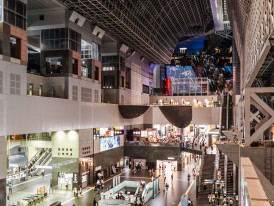
Interior of Kyoto Station showing modern architecture with traditional craft displays
Getting Your Bearings: Transportation and Layout
Arriving and Moving Around Kyoto
Most international visitors reach Kyoto through Kansai International Airport, then travel by express train to Kyoto Station, a modern architectural marvel that contrasts dramatically with the city's traditional heart.
The station itself offers your first lesson in Kyoto's blend of ancient and contemporary, with its soaring glass and steel structure housing traditional craft shops and restaurants.
From Kyoto Station, public transportation connects you to every corner worth visiting.
The subway system, while limited compared to Tokyo, efficiently serves the main tourist areas.
More importantly, many of Kyoto's most significant sites lie within walking distance of each other, particularly in the eastern districts.
Gion Shijo Station serves as an excellent base for exploring both the geisha districts and southern temple areas.
From here, you can walk to Kennin-ji Temple, Kyoto's oldest Zen temple, and continue through the historic districts without relying on transportation.

Traditional wooden buildings lining a quiet street in the Higashiyama district. Image by Kouji Tsuru from Unsplash
Understanding Kyoto's Districts
Central Kyoto encompasses the shopping and business areas around Kawaramachi and Shijo, but the spiritual heart lies in the eastern mountains.
Northern Higashiyama contains some of Japan's most photographed temples, while Southern Higashiyama offers a more intimate journey through preserved historical areas where geisha culture still thrives.

Kinkaku-ji temple reflected in still pond water. Image by Young Kane from Unsplash
Sacred Spaces: Kyoto's Temple Legacy
The Golden Pavilion That Defines Kyoto
Kinkaku-ji, the golden pavilion, appears on every Kyoto postcard for good reason.
This UNESCO World Heritage site represents the pinnacle of Ashikaga-era architecture, its gold-leafed exterior reflecting perfectly in the surrounding pond.
But having visited countless times since childhood, I've learned that the building's true beauty lies not just in its gilded surface, but in how it changes with light and season.
Early morning visits, before the tour groups arrive, shows Kinkaku-ji temple as its builders intended, a meditation on impermanence and beauty.
The beautiful gardens surrounding the pavilion follow principles established centuries ago, every viewpoint carefully designed to create specific emotional responses.
The temple's history includes destruction and reconstruction, most recently in 1955 after a young monk burned down the original structure.
This cycle of loss and renewal reflects deeper Buddhist teachings about the temporary nature of all things, making Kinkaku-ji both a visual spectacle and a spiritual lesson.
The road to Silver Pavilion through the Philosopher's Path has one of Kyoto's most contemplative walks.
What if Kyoto Felt Less Like a Checklist and More Like a Conversation?
City Unscripted pairs you with a local who listens first, then plans. That means no fixed routes, no tourist traps.

Close-up detail of gold leaf on Kinkaku-ji's exterior walls. Image by Markus Winkler from Unsplash
Hidden Temples Worth the Journey
Beyond the popular attractions, Kyoto has temples that most visitors never see.
Kurama-dera Temple, reached by a scenic train journey from central Kyoto, sits amid lush forests that have sheltered monks for over a thousand years.
The approach requires a mountain hike, but the effort rewards you with one of Japan's most atmospheric temple complexes.
Kifune Shrine, accessible from the same mountain area, becomes magical in summer when restaurants build platforms over the rushing stream.
This combination of spiritual and sensory experience exemplifies how Kyoto seamlessly blends the sacred and worldly.

Wooden torii gate. Image by Kouji Tsuru from Unsplash
The Silver Pavilion's Understated Elegance
Silver Pavilion (Ginkaku-ji) offers a different aesthetic from its golden counterpart. Built as a retreat for the shogun Ashikaga Yoshimasa, it embodies the refined simplicity that became central to Japanese aesthetics.

Carefully arranged garden stones. Image by Sunao Noguchi from Unsplash
The temple's gardens show off the highest level of landscape design, with every stone and plant positioned to create harmony between architecture and nature.
The road to Silver Pavilion through the Philosopher's Path has one of Kyoto's most contemplative walks, particularly during cherry blossom season when the canal reflects pink petals and temple roofs.

People in traditional outfits. Image by Jay Lo from Unsplash
The Imperial Legacy: Palaces and Power
Kyoto Imperial Palace: Heart of Ancient Japan
The Kyoto Imperial Palace served as the primary residence of the Imperial Family until Tokyo became Japan's capital in 1868.
Today, this sprawling complex within Imperial Palace park offers guided tours that shows off the intricate world of court life.
The palace's architecture follows Chinese principles adapted for Japanese climate and customs, with each building serving specific ceremonial functions.
Free tours, bookable online, take visitors through the main hall and private quarters, explaining court protocols that governed life here for centuries.
The beautiful gardens surrounding the palace change dramatically with seasons, offering different perspectives on imperial aesthetics throughout the year.
The palace grounds extend far beyond the residential buildings, encompassing forests and meadows that once served as hunting grounds for the imperial court.
Walking these paths provides insight into how the powerful lived when Kyoto was Japan's capital.

Palace gardens with ancient trees and traditional bridges. Image by Dendy Darma Satyazi from Unsplash
Nijo Castle: Shogun Power Made Manifest
Nijo Castle has a different kind of power, the military authority of the Tokugawa shogunate. Built in 1603, the castle served as the Kyoto residence of Tokugawa shoguns and witnessed the formal end of the shogunate in 1867.
The castle's "nightingale floors" squeak when walked upon, alerting guards to intruders, an ingenious security system that still functions today.
The castle's beautiful gardens show off different styles of Japanese landscape design, from the formal arrangements near the palace buildings to the more natural settings around the large pond. Spring brings spectacular cherry blossom displays, while autumn turns the grounds into a tapestry of red and gold.

Interior view of Nijo Castle. Image by Kouji Tsuru from Unsplash
Nijo Castle also holds significance as a UNESCO World Heritage site, recognized for its outstanding examples of palace architecture from the Edo period.
The painted screens within the palace buildings, created by artists from the Kano school, showing off the highest level of decorative art from this era.

Elaborate painted screens in Nijo Castle depicting nature scenes. Image by Tai Bui from Unsplash
Travel Deeper With a Local Host
Kyoto is full of cultural treasures, some famous, some tucked away. With City Unscripted, a local host helps you discover both.
Kiyomizu-dera temple's wooden stage extending over the valley. Image by fan yang from Unsplash
Sacred Mountains and Temple Paths
Kiyomizu-dera: The Water Temple
Kiyomizu-dera Temple, perched on the hillside overlooking Kyoto, offers perhaps the city's most dramatic temple experience.
The main hall, built without using a single nail, extends over the hillside on massive wooden supports, creating a stage-like platform that provides sweeping views of the city below.
The temple's name, meaning "clear water temple," comes from the Otowa waterfall that flows beneath the main hall.
Pilgrims have drunk from this sacred spring for over 1,200 years, believing its waters grant wishes related to love, success, and longevity.
The way to Kiyomizu-dera Temple through the Higashiyama District preserves the atmosphere of historical Japan.
Traditional wooden buildings house shops selling everything from Kyoto crafts to local sweets, creating a beautiful journey back in time.
This area becomes particularly magical in early evening when lanterns illuminate the narrow streets.

Traditional shops lining the approach to Kiyomizu-dera with lanterns. Image by Jarrett Tan from Unsplash
Fushimi Inari: The Thousand Torii Gates
Fushimi Inari Station gives you access to one of Kyoto's most photographed sites, the thousands of torii gates that create tunnels up the mountainside.
While Instagram has made this Shinto shrine world-famous, the experience of walking through these red torii gates remains profound when approached with proper reverence.
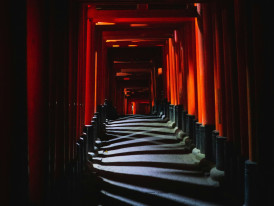
Endless tunnel of red torii gates creating a path up the mountain. Image by Alex Rainer from Unsplash
The torii gates represent donations from businesses and individuals seeking prosperity from Inari, the Shinto deity of rice and sake.
Every gate bears the donor's name and the date of installation, creating a physical record of devotion spanning centuries.
The climb to the summit takes several hours, but even short walks up the mountain provide memorable experiences.

Small shrine hidden among ancient trees with moss-covered stone lanterns. Image by Kouji Tsuru from Unsplash
JR Inari Station sits conveniently close to the shrine entrance, making this one of the most accessible attractions in Kyoto.
However, the best experiences happen away from the main paths, where smaller shrines nestle among ancient trees and the mountain's spiritual energy feels most concentrated.

The famous rock garden at Ryoan-ji. Image by Ray Wyman Jr from Unsplash
Gardens That Define Japanese Aesthetics
Ryoan-ji: The Ultimate Rock Garden
The rock garden at Ryoan-ji is the pinnacle of Japanese garden design, fifteen carefully placed stones in raked white sand, surrounded by traditional clay walls.
This moss temple (though technically famous for its rock garden rather than moss) demonstrates how simplicity can achieve profound aesthetic and spiritual impact.
Sitting on the wooden veranda facing this rock garden, visitors often experience a meditative state that words cannot adequately describe.
The garden's design ensures that no single viewpoint allows you to see all fifteen stones simultaneously, creating a metaphor for the limitations of human perception.
See Kyoto After Hours, Your Way
Skip the crowds and clichés. From tucked-away izakayas to lantern-lit lanes, a local host tailors the evening to match what you're curious about.
Tenryu-ji: Where Garden and Landscape Merge
Tenryu-ji in Arashiyama demonstrates how master garden designers integrate their creations with natural landscapes.
The temple's main garden, created in the 14th century, uses the Arashiyama mountains as "borrowed scenery," making the distant peaks appear to be part of the garden design.
The approach to Tenryu-ji through the famous bamboo grove creates anticipation for the garden's revelation.

Towering bamboo with filtered green light. Image by Jonas Jacobsson from Unsplash
Walking through these towering bamboo creates an otherworldly experience, the filtered light and rustling leaves create natural music that has inspired poets for centuries.
Tenryu-ji also serves as the head temple of the Rinzai sect of Zen Buddhism and maintains the spiritual practices that shaped the garden's original design.

Traditional landscape garden at mountains. Image by Mak from Unsplash
The temple's main hall contains painted screens depicting dragons, the temple's namesake, created by contemporary artists working within traditional frameworks.

A geisha walking a street. Image by Wenhao Ruan from Unsplash
Living Culture: Geisha Districts and Traditional Arts
Gion: Where Tradition Continues
Geisha culture remains vibrantly alive in Kyoto's Gion District, though visitors require patience and respect to witness it as it's meant to be.
The geisha districts of Gion and Pontocho continue training apprentice geisha (maiko) in traditional arts, dance, music, and conversations that have defined refined entertainment for centuries.
Evening walks through Gion's narrow streets might reward respectful observers with glimpses of geisha traveling between appointments.
These encounters feel magical, but they represent working professionals going about their business, not tourist attractions.
Yasaka Shrine anchors the Gion district spiritually and architecturally, its vermillion buildings providing a backdrop for festival celebrations throughout the year.
The shrine's autumn illuminations create some of Kyoto's most romantic evening scenes, with couples strolling through grounds that have witnessed centuries of devotion.

Yasaka Shrine illuminated at night during autumn with colorful leaves visible. Image by YANGHONG YU from Unsplash
Tea Ceremony: Meditation in Motion
Tea ceremony is the culmination of Japanese aesthetic principles such as harmony, respect, purity, and tranquility, expressed through the simple act of preparing and sharing green tea. While many visitors to Kyoto experience abbreviated tea ceremonies, the true depth of this practice reveals itself through longer sessions that emphasize meditation and mindfulness.
Traditional tea houses throughout Kyoto offer tea ceremony experiences ranging from brief demonstrations to comprehensive lessons.
The most enjoyable experiences happen in historic buildings where the tearoom's proportions and materials create the proper atmosphere for this ancient practice.

Master's hands performing tea ceremony with traditional utensils in a historical tearoom. Image by Huang 211 from Unsplash
The philosophy underlying tea ceremony extends far beyond the brewing and serving of green tea. Each gesture, each utensil, each seasonal flower arrangement contributes to a total aesthetic experience that embodies centuries of refined Japanese culture.
More than 26,223 5-star reviews and counting
26,223+ 5-Star Reviews and Counting
Trusted and recommended by travelers worldwide.

Bamboo grove pathway with early morning light filtering through. Image by Inês Conceição from Unsplash
Arashiyama: Nature and Culture in Harmony
The Bamboo Grove Experience
The bamboo grove of Arashiyama creates one of Kyoto's most distinctive natural experiences. Walking through these towering stalks feels like entering a living cathedral, with filtered light creating an ever-changing pattern of shadow and brightness.
The bamboo's natural music, a gentle rustling that changes with wind intensity, has inspired Japanese poets and musicians for centuries.
Saga Arashiyama Station provides direct access from central Kyoto, making this an absolutely worth visiting location easily accessible.
However, the best experiences happen early in the morning or late in the afternoon when most visitors have departed and the bamboo grove lets you see its more contemplative character.

Traditional wooden boat navigating the Hozu River with autumn foliage. Image by Murtaza Ali from Unsplash
River Journey: Hozu River Boat Rides
The Hozu River offers a completely different perspective on Arashiyama's natural beauty through traditional boat journeys that make their way through gentle rapids between forested mountains.
These two-hour trips, operating since the Heian period, provide insight into how historical travelers moved between Kyoto and outlying areas.
Nature lovers particularly appreciate how the Hozu River journey shows seasonal changes in the surrounding landscape.

Colorful displays of traditional Japanese ingredients and sweets. Image by François Brémont from Unsplash
Cultural Immersion: Markets and Local Experiences
Nishiki Market: Kyoto's Kitchen
Nishiki Market, known as "Kyoto's Kitchen," extends for five city blocks through covered arcades filled with vendors selling everything from traditional sweets to sake and locally grown vegetables. This 400-year-old market provides insight into Kyoto's food culture, with many stalls ran by families who have served local residents for generations.
The market's narrow aisles create intimate encounters with vendors who often speak some English and enjoy explaining their products to curious visitors.
Cooking classes using ingredients purchased at Nishiki Market provide hands-on introduction to Kyoto's distinctive cuisine, which emphasizes subtle flavors and seasonal ingredients.

Local artisan demonstrating traditional craft techniques in a small workshop setting
Green tea vendors throughout Nishiki Market offer tastings of different varieties, from everyday sencha to premium matcha used in tea ceremony.
Understanding these distinctions enhances appreciation for the role green tea plays in daily Japanese life beyond formal ceremonies.
Beyond the Tourist Trail
Recent visits to lesser-known temples and neighborhoods shows how Kyoto continues evolving while maintaining its essential character.
Local residents navigate between preserving traditions and adapting to modern needs, creating a dynamic culture that extends far beyond museum-like preservation.
Guided tours led by Kyoto residents provide access to experiences unavailable to independent travelers.
These might include private temple visits, meetings with traditional craftspeople, or meals in restaurants that don't advertise to tourists.
Such Kyoto experiences offer depth impossible to achieve through standard sightseeing.

Evening hanami party under illuminated cherry blossoms in Maruyama Park. Image by Zhaoli JIN from Unsplash
Seasonal Festivals and Special Events
Cherry Blossom Celebrations
Cherry blossom season changes Kyoto into something almost surreal, with pink petals creating natural confetti throughout the city.
The most spectacular displays happen in temple gardens and along the Kamo River, where locals and visitors gather for hanami parties celebrating spring's arrival.
Maruyama Park becomes the center of evening cherry blossom celebrations, with families and friends spreading blue tarps beneath blooming trees for picnics that continue late into the night.
The contrast between day and night hanami shows different aspects of Japanese social culture.
Less crowded but equally beautiful cherry blossom viewing happens along the Kamo River and in temple gardens throughout Northern Higashiyama.
These locations offer more contemplative experiences while still providing spectacular floral displays.

Kodai-ji temple garden illuminated at night with autumn maple leaves glowing red. Image by YANGHONG YU from Unsplash
Unique Kyoto Experiences Worth Seeking
Kodai-ji Temple's Illuminations
Kodai-ji presents some of Kyoto's most sophisticated evening illuminations, using contemporary lighting design to highlight traditional architecture and gardens.
These seasonal displays turn familiar temple grounds into dramatically different spaces, revealing how modern technology can enhance rather than compromise historical aesthetics.
The temple's autumn illuminations particularly show off the integration of beautiful gardens with architectural elements, creating scenes that feel both timeless and thoroughly contemporary. Kodai-ji demonstrates how Kyoto successfully balances preservation with innovation.
Sanjusangen-do: Hall of 1001 Buddhas
Sanjusangen-do Temple contains one of Kyoto's most overwhelming spiritual experiences, a hall stretching 120 meters containing 1,001 golden statues of Kannon, the Buddhist goddess of mercy. The visual impact of this assembly defies description, particularly when morning light streams through the hall's windows, illuminating the statues' faces.

Interior view of Sanjusangen-do showing rows of golden Buddha statues receding into the distance
This national treasure is the peak of Kamakura-period Buddhist sculpture, with each of the 1,001 statues displaying slightly different facial expressions and poses.
The hall's acoustics create an otherworldly atmosphere where even whispered conversations seem to echo among the golden figures.
Not Just Kyoto. Your Kyoto.
See Kyoto your way, with a local by your side and an experience built entirely around you.

Traditional street map showing walking routes connecting major temples and cultural sites in eastern Kyoto
Planning Your Kyoto Journey
Creating Your Personal Kyoto Itinerary
An effective Kyoto itinerary balances must-see attractions with opportunities for spontaneous discovery. Rather than rushing between top attractions, allow time for wandering through neighborhoods where daily life continues much as it has for generations.
Conveniently located temples and shrines cluster in specific areas, making it possible to visit several significant sites while maintaining a contemplative pace.
The eastern districts, accessible from Gion Shijo Station, offer the most rewarding walking routes.
Consider seasonal factors when planning your visit. Cherry blossom season and autumn foliage periods offer spectacular natural displays but also bring the largest crowds.
Summer heat can make temple visiting uncomfortable, while winter's cold creates intimate atmospheres in traditional buildings.
Transportation Between Sites
Public transportation efficiently connects Kyoto's major districts, but many of the most rewarding experiences happen during walks between destinations.
The city's compact size makes it possible to cover significant ground on foot while finding hidden temples and neighborhood shrines along the way.
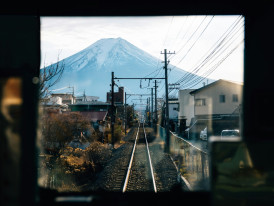
Traditional train traveling through Kyoto suburbs with mountains visible in the distance. Image by Peter Thomas from Unsplash
Visit Arashiyama requires a longer journey from central Kyoto, but the train ride itself provides views of suburban Japanese life rarely seen by tourists.
Similarly, the journey to mountain temples like Kurama-dera Temple becomes part of the overall experience rather than simply transportation.

Elderly Kyoto resident tending to a small temple garden with careful attention to seasonal plantings. Image by Mirna Wabi-Sabi from Unsplash
Beyond the Guidebook
What Makes Kyoto Special
After decades of living here, I've come to understand that Kyoto's true gift lies not in any single temple or garden, but in how the city seamlessly integrates the sacred and mundane.
Japanese culture shows itself most clearly in these moments of integration, when a simple meal becomes a meditation on seasonal ingredients, or when a walk through temple grounds provides insights into aesthetic principles that have shaped Asian civilization.
While guidebooks often focus on major temples and tourist hotspots, the most memorable experiences come from finding the cool things to do in Kyoto, Japan that locals cherish.
Intimate tea ceremonies in hidden teahouses, early morning walks through temple gardens before crowds arrive, and seasonal festivals that show off the city's living traditions rather than its preserved monuments.
Lasting Impressions
Visit Kyoto with the understanding that this city rewards patience and respect.
The best experiences often happen in quiet moments between scheduled activities. Sitting in a temple garden as evening approaches, spotting a neighborhood shrine during an aimless walk, or simply observing daily life continue around ancient traditions.
The city's cultural heritage extends beyond its designation as a UNESCO World Heritage site.
It lives in the techniques passed down through generations of craftspeople, in the seasonal changes that still govern temple festivals, and in the quiet pride of residents who understand their role as custodians of irreplaceable traditions.
Your Kyoto book of memories will likely include famous sites like the golden pavilion and torii gates of Fushimi Inari, but it should also contain moments of personal discovery.
Conversations with local residents, unexpected encounters with traditional arts, and the gradual understanding that comes from moving slowly through a city where every stone holds stories.
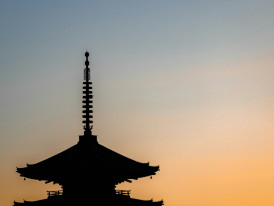
Sunset view over Kyoto's traditional rooftops with temple pagodas silhouetted against mountains. Image by Ricky from Unsplash
Worth visiting means different things to different travelers.
But in Kyoto, the most valuable experiences require opening yourself to perspectives that may challenge modern expectations about efficiency and entertainment.
This ancient city offers its greatest gifts to those who approach with curiosity, respect, and the willingness to be changed by what they encounter.
The best things to do in Kyoto ultimately involve becoming, temporarily, part of a culture that has spent centuries refining the relationship between human creativity and natural beauty.
Whether you're watching cherry blossoms fall into temple ponds or participating in a tea ceremony that follows protocols established hundreds of years ago, you're engaging with traditions that continue because each generation finds in them something essential and irreplaceable.
In our rapidly changing world, Kyoto stands as proof that preservation and progress need not be opposites, that ancient wisdom and contemporary life can coexist, and that some experiences transcend the merely photogenic to become genuinely transformative.
This is what I hope every visitor discovers during their time in my beloved city.
Kyoto: Personalized. Flexible. Never scripted.
SEE EXPERIENCESSee Kyoto with Someone Who Knows It Inside Out
Discover Kyoto with a local who tailors the experience to you. No scripts, no crowds, just a day shaped by your interests and curiosity.
Planning Tokyo Too? Chat With a Local Who Gets It
Got questions about Tokyo? Speak with a local host who knows the city and how to shape a trip that fits you.
